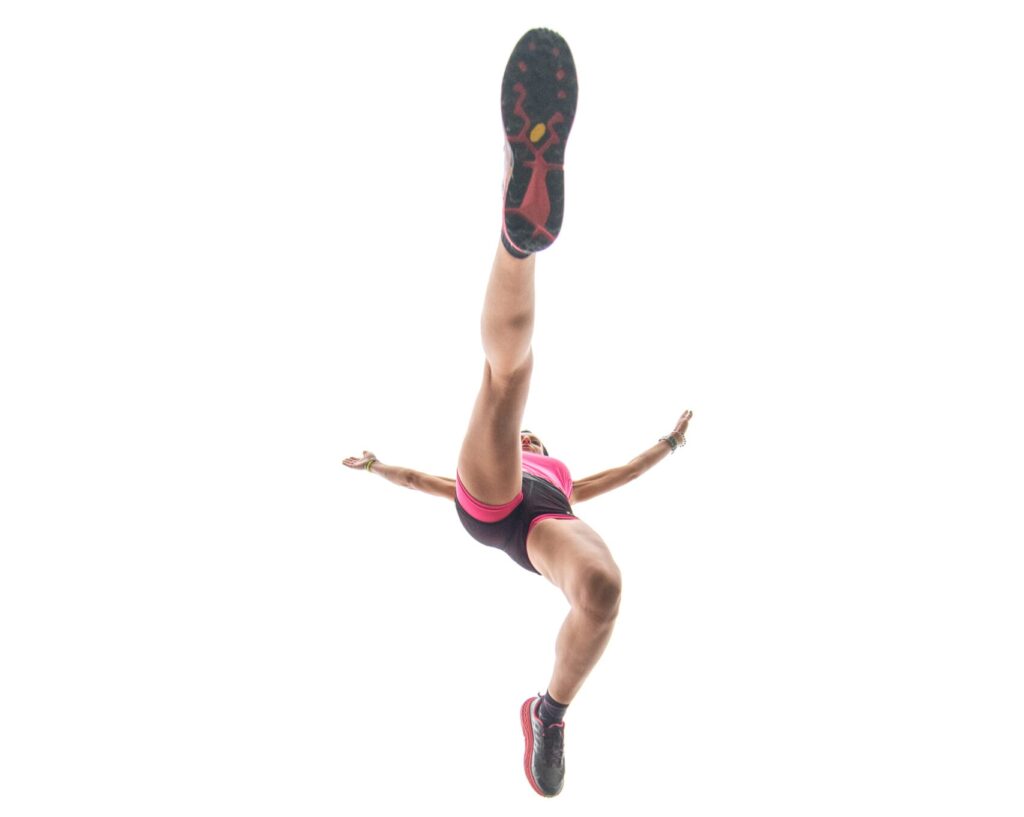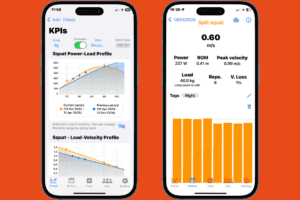When it comes to improving athletic performance, drop jumps are a staple exercise in the world of plyometrics. They are designed to enhance explosive power, reactive strength, and vertical jump mechanics—all critical components for athletes across various sports. But what exactly are drop jumps, and how do they compare to similar exercises? Can they really increase your vertical jump, and what muscles do they target? In this blog, we’ll dive deep into these questions and more, offering a comprehensive guide to drop jumps while introducing variations and insights that cater to athletes and fitness enthusiasts alike. Whether you’re asking, “What is the difference between depth jumps and drop jumps?” or “Why can’t I jump higher despite strong legs?”—we’ve got you covered.
DOWNLOAD SPLEEFT APP NOW FOR iOS, ANDROID AND APPLE WATCH!
Drop Jumps: A Complete Guide
What Is a Drop Jump?

A drop jump is a plyometric exercise where an athlete steps off an elevated surface (such as a box), lands on the ground, and immediately jumps vertically as high as possible. The key to a successful drop jump is minimizing ground contact time while maximizing the upward force, making it a powerful exercise for developing explosive power and reactive strength.
The main purpose of a drop jump is to train the stretch-shortening cycle (SSC), which allows muscles to store and release elastic energy efficiently during rapid movements. By targeting the SSC, drop jumps enhance neuromuscular coordination, power production, and athletic performance.
If you’re wondering, “What is a drop jump used for?”—it’s primarily included in training programs to:
- Improve vertical jump height.
- Enhance speed and agility for sports like basketball, volleyball, and soccer.
- Build reactive strength, which is essential for quick changes in direction.
With tools like Spleeft, athletes can track key performance metrics during drop jumps, such as jump height, ground contact time, and peak velocity, ensuring consistent improvement and optimized results.
Understanding Drop Jumps and Variations like Depth Jumps
What Is the Difference Between Depth Jumps and Drop Jumps?
While drop jumps and depth jumps are often confused, they serve different purposes and focus on distinct aspects of athletic performance.
- Drop Jumps: Focus on minimizing ground contact time while achieving maximum vertical jump height. They are all about speed-strength and reactive power.
- Depth Jumps: Involve stepping off a platform and performing a secondary jump or movement, such as a broad jump or lateral hop. These exercises emphasize eccentric strength, which is the ability to absorb force effectively.
If you’re asking, “Which is better, depth jumps or drop jumps?”, the answer depends on your training goals. Drop jumps are better for developing vertical jump height and reactive strength, while depth jumps are ideal for building eccentric control and multi-directional power.
Using Spleeft, you can measure the effectiveness of both exercises by tracking metrics like RSI-Mod (reactive strength index), jump height, and velocity. This data allows you to tailor your training to meet specific performance goals.
Do Drop Jumps Increase Vertical Jump?
Yes, drop jumps are one of the most effective exercises for increasing vertical jump performance. By training the SSC and improving the efficiency of muscle and tendon elasticity, drop jumps teach your body to generate explosive power more effectively.
How Drop Jumps Improve Vertical Jump:
- Activating Fast-Twitch Fibers: Drop jumps target the fast-twitch muscle fibers responsible for explosive movements like jumping and sprinting.
- Improving Ground Contact Time: Shortening the time your feet are on the ground maximizes the energy transfer during takeoff.
- Enhancing Neuromuscular Coordination: Drop jumps improve the synchronization of muscle groups needed for optimal jumping mechanics.
Wondering, “Do drop jumps work better than other exercises for vertical jump improvement?” The answer lies in how they complement your training. Combining drop jumps with strength exercises like squats and velocity-based training (measured using Spleeft) ensures a comprehensive approach to jump development.
Tracking your 1 PR (personal record) in exercises like drop jumps is essential for monitoring progress and ensuring that your vertical jump performance improves over time. Apps like Spleeft make it easy to measure jump height and ground contact time, helping you break your PRs consistently and track your achievements.
What Are the 4 Types of Jumps?
When planning your training, it’s essential to understand the different types of jumps and how they target various athletic skills. Here are the four main types of jumps:
- Vertical Jumps: Focused on height, such as drop jumps, countermovement jumps (CMJs), and squat jumps.
- Horizontal Jumps: Emphasizing distance, such as standing long jumps and bounding drills.
- Lateral Jumps: Training side-to-side power and agility, often used in sports like tennis and soccer.
- Depth Jumps: Combining eccentric control with explosive movements for overall power development.
Each jump type serves a specific purpose, so incorporating a variety of jumps into your routine ensures well-rounded athletic development.
Muscles and Mechanics of Drop Jumps
What Muscles Do Drop Jumps Work?

Drop jumps are a lower-body powerhouse exercise, but they also engage stabilizing muscles throughout the body. Here’s a breakdown of the muscles targeted:
- Quadriceps: Power the extension of the knees during the takeoff phase.
- Glutes: Drive hip extension, a key component of explosive jumping.
- Hamstrings: Assist in stabilizing the knee and hip during landing and takeoff.
- Calves: Propel the body off the ground by extending the ankles.
- Core: Stabilizes the torso and ensures proper alignment throughout the movement.
If you’re curious, “Why can’t I jump high even though my legs are strong?”, the issue might lie in the coordination between these muscle groups. Exercises like drop jumps improve this coordination while building the explosive power required for higher jumps.
Why Are My Legs Strong but I Can’t Jump High?
If your legs are strong but your vertical jump is lacking, consider the following factors:
- Neuromuscular Efficiency: Strong muscles don’t guarantee efficient coordination for explosive movements.
- Reactive Strength: Your ability to store and release elastic energy may be underdeveloped.
- Jump Technique: Improper mechanics can waste energy and limit jump height.
Solutions:
- Incorporate drop jumps to improve reactive strength.
- Use Spleeft to analyze metrics like ground contact time and peak velocity, identifying areas for improvement.
Vertical Jump and Drop Jump Connection
Is Vertical Jump Mostly Genetic?
Genetics play a significant role in determining your vertical jump potential, influencing factors like:
- Muscle Fiber Composition: A higher percentage of fast-twitch fibers boosts explosive power.
- Tendon Elasticity: Determines how efficiently you can store and release energy.
- Body Proportions: Longer legs and favorable limb mechanics can enhance jumping ability.
However, training can significantly improve your vertical jump regardless of genetics. Exercises like drop jumps and velocity-based training (monitored with Spleeft) allow you to maximize your genetic potential.
What Is the Average Vertical Jump for a Normal Person?
The average vertical jump depends on factors like age, gender, and fitness level:
- General Population: 15-20 inches (38-50 cm).
- Athletes: 20-28 inches (50-71 cm).
- Elite Athletes: Over 30 inches (76 cm).
Understanding these benchmarks can help you set realistic goals. Tracking your progress with Spleeft ensures that you’re consistently improving relative to these standards.
Is 30 Inches a Good Vertical Jump?
A 30-inch vertical jump is considered excellent for most athletes. Here’s a breakdown:
- Recreational Athletes: 15-20 inches (38-50 cm) is average.
- Competitive Athletes: 20-30 inches (50-76 cm) is strong.
- Elite Athletes: Over 30 inches (76 cm) is exceptional.
Achieving a 30-inch vertical requires consistent training, including strength work, plyometrics like drop jumps, and neuromuscular coordination.
What Is Considered a High Jump?
A high jump is generally:
- Above Average: Over 20 inches (50 cm) for recreational athletes.
- Elite Level: Over 30 inches (76 cm) for competitive athletes.
Setting a target for a “high jump” can motivate your training. Spleeft helps you track every jump, so you’ll know exactly when you hit your goal.
Performing Drop Jumps Effectively
What Is the Best Height for a Drop Jump?
The ideal height for a drop jump varies based on your experience level and training objectives:
- Beginners: Start with a height of 12-18 inches (30-45 cm) to focus on proper form.
- Intermediate Athletes: Progress to 18-30 inches (45-75 cm) to develop more advanced power and coordination.
- Advanced Athletes: Use heights of 30-40 inches (75-100 cm) to push your limits and maximize reactive strength.
Using Spleeft, you can experiment with different heights and measure their impact on metrics like RSI-Mod and jump height, ensuring you’re optimizing your training.
When it comes to measuring drop jump performance, the debate between Apple Watch vs Whoop often comes up. The Apple Watch integrates seamlessly with apps like Spleeft, allowing you to monitor metrics like jump height in real-time. On the other hand, Whoop excels in tracking recovery and strain, making it a great complement for managing overall athletic performance. Choosing between Whoop vs Apple Watch depends on your priorities—real-time feedback or long-term recovery insights.
What Are the 3 Types of High Jump?

While drop jumps focus on explosive power, the high jump is a technical event in track and field. It features three main techniques:
- Scissors Jump: An older technique where the jumper crosses the bar feet first.
- Straddle Technique: The jumper faces down as they clear the bar, replaced by the Fosbury Flop.
- Fosbury Flop: The modern standard, where the jumper arches their back and clears the bar headfirst, landing on their back.
Though not directly related, training with drop jumps can improve the vertical power needed for high jump performance.
Conclusion: Unlock Your Athletic Potential with Drop Jumps
Drop jumps are a cornerstone of plyometric training, offering a pathway to improved vertical jump performance, reactive strength, and overall athleticism. By understanding their mechanics, targeting the right muscles, and incorporating them into your routine, you can unlock new levels of performance.
Whether you’re wondering, “What is the best height for a drop jump?” or trying to improve your vertical jump despite strong legs, drop jumps provide a solution. Tools like Spleeft enhance the training process by providing real-time feedback on metrics like jump height, RSI-Mod, and ground contact time.
Start incorporating drop jumps into your training today, track your progress with Spleeft, and achieve explosive gains that will take your athletic performance to the next level.
Using tools like Spleeft, you can effortlessly calc 1RM (calculate your one-repetition maximum) by analyzing your load-velocity profile. This feature ensures you’re lifting the optimal weight during strength training sessions, maximizing your power output while minimizing fatigue. Incorporating drop jumps alongside your strength program and using tools to calc 1RM will take your athletic potential to the next level.
Iván de Lucas Rogero
MSC Physical Performance & CEO SpleeftApp
Dedicated to improving athletic performance and cycling training, combining science and technology to drive results.





